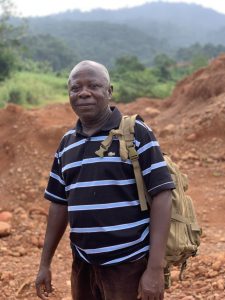Hope for justice for Ñembi Guasu
15 April, 2025
Friday 28 july 2023
Header photo: Atewa forest © IUCN NL
The Atewa Forest Reserve in eastern Ghana covers 263 km2 and represents a unique tropical highland rainforest. It is classified as Globally Significant Biodiversity Area, an Important Bird Area (IBA) and a Key Biodiversity Area (KBA), and as such it is internationally recognized as one of the highest priority ecosystems.
The Atewa Forest is home to a wide variety of plants and animals, some of which are found only in this area. The forest contains more than 860 species of plants and more than 570 species of butterflies. It is also home to several threatened and near-threatened species, among which the white-naped Mangabey, one of the 25 most threatened species of monkey worldwide.
The Ayensu, Birim and Densu rivers originate from the Atewa Forest. The Densu river alone supplies water to at least 5 million Ghanaians, including 1 million residents of the capital Accra. The Ayensu river mainly supplies water to the central region of the country and the Birim river has an important role in the eastern region for irrigational purposes.
The forest also supports livelihoods of 53 communities living on the edge of the forest, as the reserve provides drinking and irrigation water and a unique micro-climate for local agriculture.
In the Atewa Forest Reserve, biodiversity and the water provisioning are under pressure. This is due to weak governance, inadequate law enforcement and lack of participation of local communities in the management of the reserve. Despite its legal status as a forest reserve, the forest is being degraded by illegal activities such as logging, hunting, farming and gold mining. Moreover, there are plans for large-scale bauxite mining in the area. Bauxite is the primary ore of aluminum.
Emmanuel Tabi grew up in the Atewa Forest landscape and is now the coordinator of the Concerned Citizens of Atewa Landscape, a community-based organization with about 500 members from Atewa’s 53 communities. ‘We have realized that we need to do more to protect the forest so that it can continue to provide us the important ecosystem services. About 80 percent of the people from the communities living around Atewa are working in agriculture. If the forest disappears, the rainfall pattern in the region will change and that will have a severe impact on the livelihoods of many people. Furthermore, 200 streams take their source from the Atewa Forest. They pass through the communities and people rely on these streams. When they dry up or become polluted as a result of the mining, many lives and livelihoods will be at stake,’ Tabi explains.

‘The forests also provide many medicinal plants, for example mahogany’, Tabi continues. ‘And it has an important spiritual value for us. We believe trees have spirits, and rivers have spirits. There, for example, are two rivers called Sarworben and Wankobri which we believe protect our people. We have to protect the trees and rivers to protect ourselves, both in spiritual as well as in more practical ways. Concerned Citizens of Atewa Landscape is educating people in the Atewa communities about that.’
Although education at the community level is still the organizations main focus, in recent years there has been a shift towards advocacy against bauxite mining. In 2017, the Republic of Ghana signed a Memorandum of Understanding with the Chinese state-owned Sinohydro Corp Limited to develop a bauxite industry in Ghana with Atewa Forest as one of the sources of raw materials. Ever since, civil society organizations have been fighting for the protection of the Atewa Forest.
Bauxite is a sedimentary rock that forms the world’s main source of aluminum. Aluminum is considered essential for the energy transition as it powers many low-carbon technologies such as wind turbines and batteries. It is also essential for solar photovoltaic (PV) technologies[1]Source: https://blogs.worldbank.org/energy/cost-competitive-low-carbon-aluminum-key-energy-transition. The World Bank estimates that demand for aluminum will more than double in a 2-degree climate scenario.
Bauxite is usually extracted from the topsoil through a method called strip mining, which requires removing layers of soil and rock to access the minerals below. This means all trees and other vegetation are cleared from the area, together with the species living in it. ‘In practice this would mean the end of the Atewa Forest with its unique biodiversity and its important ecosystem services,’ Tabi explains.
‘We are not against bauxite mining as such, we are only saying that the Atewa Forest is too precious. Also, according to information available to the government, there are far richer bauxite reserves in the country. Ghana does not need to exploit the Atewa Forests bauxite reserves’, Tabi stresses.
Ghana has very little forest left and, despite commitments to end deforestation, had the highest loss percentage among all tropical countries in 2022[2]Source: https://www.globalforestwatch.org/blog/data-and-research/global-tree-cover-loss-data-2022/. According to Global Forest Watch, part of the forest loss is linked to cocoa production and forest fires. Mining is also a significant cause of deforestation in Ghana[3]Source: A pantropical assessment of deforestation caused by industrial mining (2022): https://www.pnas.org/doi/full/10.1073/pnas.2118273119 with gold mining being the largest industry in the country, but other resources such as bauxite and manganese are also extracted. Bauxite mining in the Atewa Forest would have disastrous consequences for the rich biodiversity and ecosystem services it provides.
‘Luckily the traditional leaders and the members of Parliament within the Atewa landscape understand the importance of the ecosystem services the forest reserve provides. Together, we strongly advocate for a National Park status for the Atewa Forest. That way, we can protect the forest and the over 1 million Ghanaians who directly depend on it,’ Tabi concludes.
IUCN NL is supporting organizations in Ghana, like A Rocha Ghana and the Concerned Citizens of Atewa Landscape, in their fight for the protection of the Atewa Forest through various programmes, including Strengthen the Roots, Forests for a Just Future and Bottom Line.

| ↑1 | Source: https://blogs.worldbank.org/energy/cost-competitive-low-carbon-aluminum-key-energy-transition |
|---|---|
| ↑2 | Source: https://www.globalforestwatch.org/blog/data-and-research/global-tree-cover-loss-data-2022/ |
| ↑3 | Source: A pantropical assessment of deforestation caused by industrial mining (2022): https://www.pnas.org/doi/full/10.1073/pnas.2118273119 |